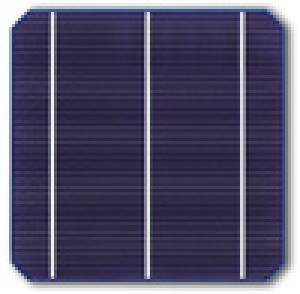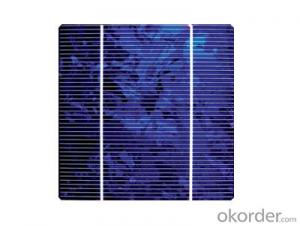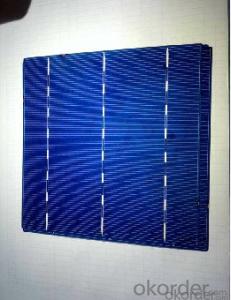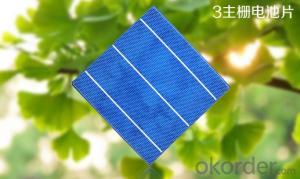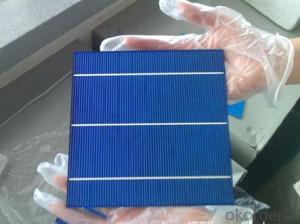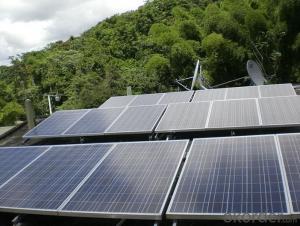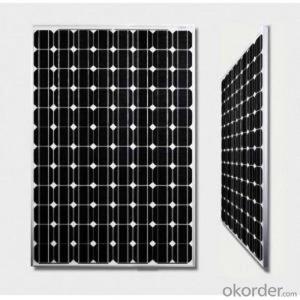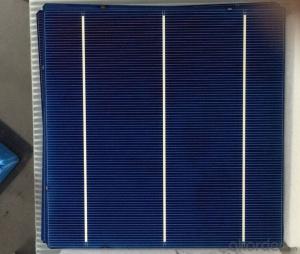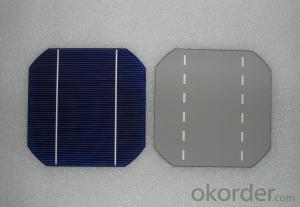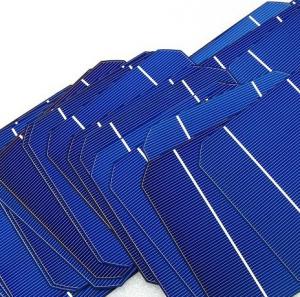Used PV Mono 3BB Solar Cells for Sale
- Loading Port:
- China Main Port
- Payment Terms:
- TT OR LC
- Min Order Qty:
- -
- Supply Capability:
- -
OKorder Service Pledge
OKorder Financial Service
You Might Also Like
Introduction:
We supply regular mono 125x125mm and poly 156x156mm solar cells.
Cells made in China mainland and Taiwan are both available.
Cell production capacity yearly reach 1GW.
Our cells pattern include continuous and uncontinuous busbar to meet different cells line.
THE CHARACTERISTIC OF 156P POLY-SILICON SOLAR CELLS
1.Format 156mm×156mm±0.5mm,Thickness 210μm±30μm.
2.High efficiency in photovoltaic conversion 16.3%~17.93%;
3.Low inverse current, high shunt resistance and high dependability.
4.Front(-): covered by dark blue silicon nitride anti-reflecting coating(silicon nitride) with bus bars(silver), 2/3/5 bud bars(silver).
5.Back(+): wide soldering pads(silver), back surface field(aluminum),high quality paste for the BSF and the electrode ensure higher tension and improve soldering easiness.
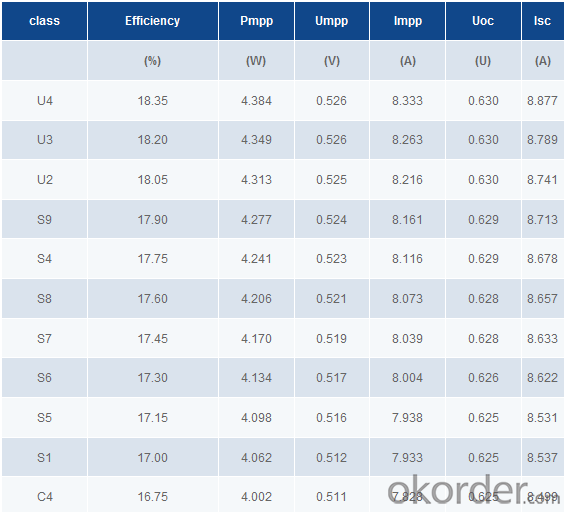
- Q: How do solar cells handle voltage fluctuations in the grid?
- Solar cells do not directly handle voltage fluctuations in the grid. However, they can contribute to stabilizing the grid by generating electricity from sunlight, which helps balance the supply-demand equation. To manage voltage fluctuations, grid operators use various methods such as energy storage systems, inverters, and smart grid technologies that can regulate and control the flow of electricity in the grid.
- Q: What is the impact of hurricane-force winds on solar cell efficiency?
- The impact of hurricane-force winds on solar cell efficiency can be significant. Strong winds can cause physical damage to the solar panels, such as cracks or detachment, which can reduce their ability to generate electricity. Additionally, debris carried by the winds may also damage the panels, further decreasing their efficiency. Therefore, it is crucial to ensure proper installation and structural resilience to mitigate the negative effects of hurricane-force winds on solar cell efficiency.
- Q: Are solar cells durable?
- Yes, solar cells are generally durable. They are designed to withstand various weather conditions, including rain, snow, and extreme temperatures. Additionally, most solar cells come with warranties that guarantee their performance for several decades.
- Q: How do solar cells perform in areas with limited space for installation?
- Solar cells can still perform efficiently in areas with limited space for installation through the use of innovative technologies such as rooftop and building-integrated photovoltaics. These systems maximize the use of available space, allowing solar cells to generate electricity even in compact urban environments. Additionally, advancements in solar cell design and efficiency have made it possible to produce more power from smaller areas, further optimizing electricity generation in limited spaces.
- Q: Can solar cells be used in aircraft applications?
- Yes, solar cells can be used in aircraft applications. Solar cells have been integrated into various aircraft designs, including drones and solar-powered airplanes. They are used to capture sunlight and convert it into electricity, which can be used to power the aircraft's electrical systems or recharge its batteries. Solar cells offer a renewable and sustainable source of energy, reducing the reliance on traditional fossil fuels and making aircraft more environmentally friendly.
- Q: What is the impact of tree shading on solar cell efficiency?
- Tree shading can significantly reduce solar cell efficiency as it obstructs sunlight from reaching the cells. When trees cast shadows on solar panels, the panels receive less sunlight, resulting in decreased energy generation. This shading causes a decrease in the overall output of the solar array, reducing its efficiency and potentially impacting the viability of the solar power system as a whole.
- Q: Is the polymer solar cell the cheapest type among all the different kinds of solar cells?
- Yes, the polymer solar cells are the cheaper type.
- Q: How does the solar panel produce it yourself?
- ?The second step: the use of natural fuel for the titanium dioxide coloring, the fresh or frozen black plum, plum, pomegranate or black tea, with a tablespoon of tax for extrusion, and then put the titanium dioxide film for coloring, about 5 Minutes until the film becomes dark purple. If the two sides of the film coloring uneven, you can put in the soak for 5 minutes, then rinse with ethanol, and gently wipe with soft paper.
- Q: How do solar cells perform in areas with limited sunlight?
- Solar cells generally perform less efficiently in areas with limited sunlight. This is because solar cells rely on sunlight to convert light energy into electricity. In areas with limited sunlight, such as regions with frequent cloud cover or high latitudes, solar cells may generate less electricity or even fail to produce any power at all. However, advancements in solar cell technology, such as the development of more efficient and sensitive materials, have improved their performance in low-light conditions to some extent.
- Q: How does a solar cell raise industrial efficiency?
- A solar cell provides long-lasting electricity which is vital in factories, that's how it raises efficiency.
Send your message to us
Used PV Mono 3BB Solar Cells for Sale
- Loading Port:
- China Main Port
- Payment Terms:
- TT OR LC
- Min Order Qty:
- -
- Supply Capability:
- -
OKorder Service Pledge
OKorder Financial Service
Similar products
Hot products
Hot Searches
Related keywords
